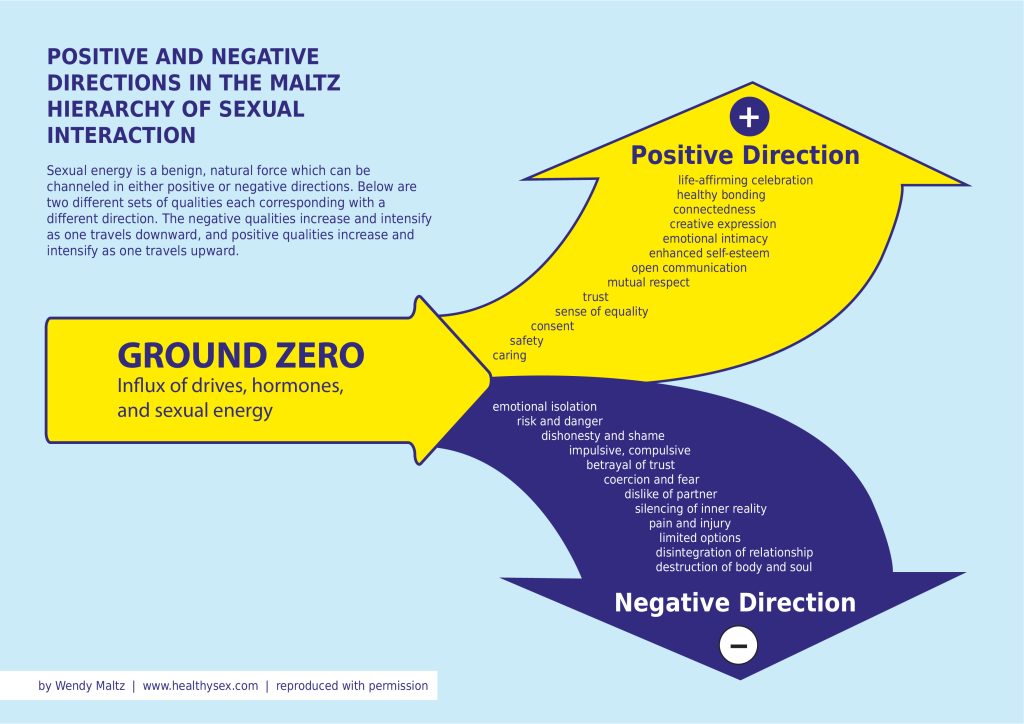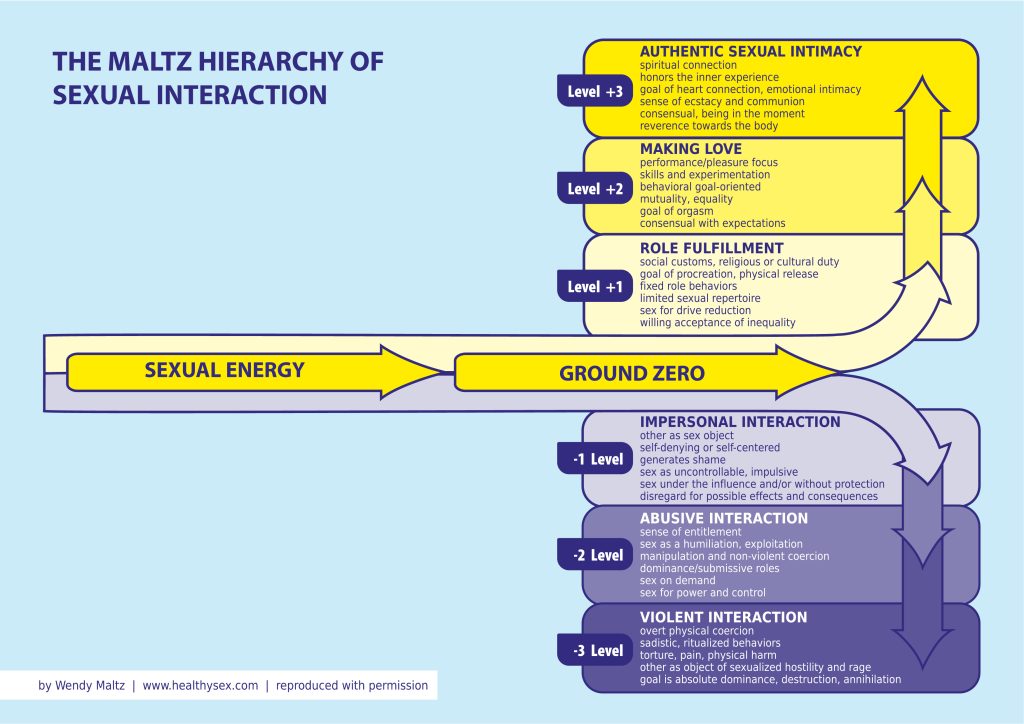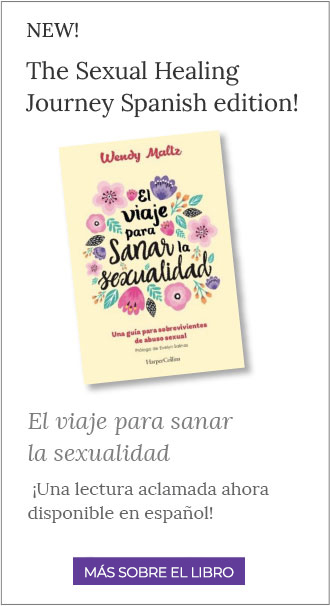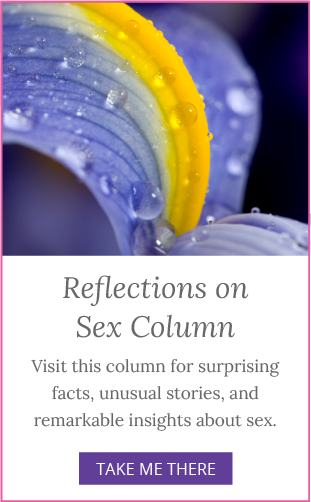One day when I was in my late 40s, I was standing in line at a little bakery in Cannon Beach, Oregon thinking about the fact that I hadn’t had a period for months and worrying what that would mean for my sexuality. In front of me was a couple wearing matching blue jean jackets and hats, barely able to keep their hands off each other. She had her arm around his waist under his jacket, rubbing up and down on his back, while his hand gently massaged her butt. They giggled like school kids. Ah, young love, I thought to myself. Their sexual energy was palpable, and I was more than a little envious. Just then they took off their hats and turned around. These young lovers, these school kids must have been at least 70-something! Her hair was white; his was a distant memory. They were both wearing gold and turquoise jewelry against their wrinkled skin. And, oh, those smiles. Smiles that said “We had sex this morning!”
That day in the bakery I had come face to face with a woman much older than myself and experienced firsthand the strength of her sexual energy. The experience went a long way towards reassuring me that, regardless of all the hormone and desire fluctuations of menopause, as a middle-aged woman my sexual future could be as bright as I chose to make it.
As a seasoned sex and relationship therapist, I knew that maintaining a good sex life has a lot to do with getting accurate information, developing positive attitudes, having access to helpful interventions, and learning new behaviors that can be put into play when needed. The biggest issue for most of us as we age is not the natural sexual change that our bodies go through, but our general tendency to ignore sexual concerns due to feeling embarrassed about sex. Self-inflicted isolation and avoidance can produce a lot of needless suffering and missed opportunities for pleasure.
In the years following my experience at the Cannon Beach bakery, I became fascinated with researching, learning, and passing on to others the secrets to staying sexually vibrant as we age. Here are a few key ideas that I discovered to help empower anyone, regardless of sexual orientation or preferences, who wants to stay hot and sexy in midlife and beyond.
Sex is ageless
Unlike other species, we humans have a sexuality that lasts well beyond the years of fertility and procreation. In fact, barring serious health problems, we have the ability to stay sexually active (with or without a partner) until we die. Freda, an 87-year-old poet I interviewed, told me that she enjoyed pleasuring herself to orgasm every day by imagining a man with a big erection wanting to make love to her. “You never lose your fancies,” Freda chuckled, “Your fancies never die.”
Numerous sexuality surveys reveal that many people in their 50s, 60s, 70s and beyond, continue to enjoy sex regularly. One-third of postmenopausal women report no change in their sex lives, and another third say their sexual experiences have actually improved with age. Consider the upside: no messy periods, more privacy at home with children gone, and more time to develop intimacy and enjoy sensual moments with or without a partner.
Women who report a decrease in sexual satisfaction usually attribute this change for the worse to vaginal dryness, lack of a partner, health problems, and relationship difficulties. Similarly, men reporting diminished sexual satisfaction in midlife often cite untreated erectile difficulties, along with troubling health and relationship concerns, as the cause.
It’s normal and natural for hormone levels to fluctuate and gradually decrease with age. Sexual problems occur when a woman’s lowered estrogen levels produce symptoms such as night sweats, hot flashes, skin sensitivity and vaginal atrophy, that interfere with sexual enjoyment. And, regardless of gender, low levels of testosterone (known as the hormone of desire) can decrease sexual fantasies and diminish sexual thoughts and cravings.
People in midlife also tend to have an increased use of medications, many of which, such as high blood pressure meds and anti-depressants, are notorious for negatively impacting sexual functioning. Some individuals face sexual challenges caused by the impact of important surgeries. However, these issues don’t have to be deal breakers for maintaining a good sex life. A wide variety of effective traditional and alternative medicines and interventions are available to address the sexual problems caused by natural aging, hormone, surgical, and medication-related concerns.
Given the information and help now available, many people in midlife can continue to experience sexual interest, arousal, and orgasm for a very long time. As with any physical response (e.g., vision, hearing, or physical activity), though, we need to accept and work with the idea that some gradual slowing down and natural weakening occurs as time goes on. Actor Jack Lemmon once quipped, “After a certain age, I found out not only did it take twice as long to rev up my motor, but it stalled frequently.” The trick is to learn to be comfortable with and adjust to changes in our bodies and their abilities, and to seek help when we need it, rather than giving up on sex altogether because it’s different than it was when we were younger. When she was well over fifty, silver screen actress Mae West once said, “Fifty men outside? I’m feeling a little tired. Send ten of them home.”
Sexual fitness makes a difference
Good sex has a lot to do with stamina, flexibility and blood flow. Thus, keeping yourself in general good health — by eating well, exercising regularly and not smoking – may be the most important thing you do to keep sex alive as you age. Low-fat, high fiber eating in small amounts throughout the day can help you have more energy and ward off that sluggish, uncomfortable (“I’d rather sleep than make love”) feeling. And if you want choice in lovemaking positions and want to be physically spontaneous and intense at times, you will probably need to build muscle strength and stamina with yoga (flexibility), weight training (strength), and aerobic activities (stamina and heart health.) One study showed that a good workout on an exercise bike increased sexual interest in women more than a candlelit dinner. The more blood flow to your genitals, the healthier they will be and more you will feel like a sexual being.
But your biceps and thighs aren’t the only muscles in your body that need continued exercise and attention for good sex. Regardless of your gender, you need to keep your pubococcygeus muscle – or PC muscle, for short – in shape. In animals, the PC is the muscle that wags the tail. In women and men, it’s the muscle that contracts when we climax. The PC muscle is a hammock-like muscle that extends from the pubic bone to the coccyx (tail bone). Also known as the “love muscle,” the PC holds up our sex organs. When it is thick and strong it gives good support (and keeps us from peeing when we laugh or cough) and when it is weak, it can reduce pelvic blood flow and cause weak orgasms or no orgasms at all.
To keep your PC muscle strong for enjoyable sex, you will need to exercise it frequently – ideally, daily, for the rest of your life! No, I’m not kidding. This one belongs right up there with flossing and bathing regularly. The standard PC exercise consists of TIGHTENING, HOLDING, and RELAXING the muscle over and over again — sometimes quickly, sometimes slowly — for up to 100 times a day. Also known as “Kegel exercises” these PC exercises are effective in treating urinary incontinence and, for women, in improving recovery after childbirth.
Many people have told me that they experience stronger, longer-lasting orgasms when their PCs are in shape. (Doctors often provide detailed descriptions of the Kegel exercises to patients, and they are often described in childbirth and human sexuality books.) Sex therapists recommend them to men who want better body awareness so they can last longer before climaxing in sex. PC exercises can be tedious and time-consuming. People who do them regularly have learned to integrate them in with activities such as when in a car waiting for a light to turn, texting, or streaming their favorite shows. You may also find at times that a few sets of PC exercises will increase sexual arousal. Thus, they can be great to do when waiting for your lover to join you in bed or when fantasizing about a hot date.
Comfortable settings, comfortable bodies
The older we get, the more we need to focus on being comfortable in sex. Creating settings for lovemaking and self-pleasuring that are relaxed and relatively stress free makes everything about sex more pleasurable. Mute your cellphone. Play some soft, sensual music. Give yourself lots of time. Make sure you have lots of privacy.
It’s important to identify what you need to feel more comfortable sexually and then give yourself permission to take action. Mattie, a 52 year-old, self-described hot and sexy midlifer, likes to keep a wide variety of different size and shape pillows near her bed. This way she has them handy when making love to prop up a hip or a lover’s head. Max, a man in his late 60s, does a series of warm ups and stretches to loosen his limbs before climbing into bed, to reduce the possibility of pulling a muscle or getting a cramp. Joan, a woman in her mid-40s, suddenly developed a self-consciousness about her own vaginal odor. This new anxiety made it difficult to touch herself at night. To remedy this concern, she created a ritual of gently cleansing her vaginal opening and lips before retiring to bed.
But it’s not just external comforts that need addressing. It’s important to be sensitive and responsive to how you feel in more intimate ways, as well. For instance, it is natural for vaginal lubrication to diminish as people age. The ability to lubricate can fluctuate according to our levels of stress, hormonal changes, and the influence of various medications. Many women express concerns with vaginal dryness in midlife. A lack of vaginal lubrication can create discomfort for both women and their partners. And sex toys can become distracting, sometimes painful, irritants when the sensitive body parts they are attempting to pleasure are dry.
Continuing to have sex when you feel physically uncomfortable could damage tissues, or at the very least, promote negative feelings about sex. Older women are more susceptible to bladder and vaginal infections, so it’s a good idea to consult a health care professional when problems with vaginal discomfort persist. Ask your doctor about what types and brands of lubricants are best suited for you to use alone or with a partner, and use them liberally during self-pleasuring and lovemaking. Speak up and stay informed, as some lubricants contain ingredients that are not considered safe for use with condoms or for medical reasons.
Doctors often recommend treating serious problems with vaginal dryness and soreness with hormone creams that are applied directly to the vaginal tissues. When Toby, a 49 year-old who had been skipping periods for several years, consulted her doctor, she was surprised to learn that her vaginal discomfort and dryness problems could be traced to visible changes in the cushioning layers of her vagina. She went on a program of inserting .5 gram of estriol cream (from a compounding pharmacy) twice a week. It plumped up the tissues to where she rarely needs to use lubricant anymore. Toby says, “I feel like I’m 25 again. . . that is, on the inside, where it counts!”
It’s time for new thoughts and a few new moves
Midlife is a great time to move away from thinking that you have to look a certain way in order to deserve and enjoy sex. Good sex is not a matter of how you look, but rather depends on how you feel and what you choose to do. All of us can be sexy at any age if we accept and appreciate our incredible bodies and tune into enjoying touch and other sensual pleasures. There is no time like the present to put on those silk sheets, light some candles, and spend an afternoon with your lover and a jar of chocolate body paint – or whatever turns you on.
Given the natural physical changes that occur during midlife, it’s a good idea to develop skills for enjoying deeper sensual and emotional connection. Wanting something different from his sexual encounters, Daniel, a single gay man in his late 60s, took a “men’s touch” retreat where he learned how to make better eye contact, expand his ability to give and receive sensual massage, and communicate his emotional feelings with other men.
The willingness to be creative and open to new things is one of the best ways to keep sexuality alive as you age. Studies show that the couples who have satisfying long-term sex lives are those who are open to experimentation. Vibrators, sex toys, romance novels, and sexually explicit materials of your choice can add to excitement and help get the juices flowing. Think about Grace and Frankie and their vibrators for older women; what great role models for healthy, sexy aging! (You can also find inspirations in my best-selling anthologies: Passionate Hearts: The Poetry of Sexual Love and Intimate Kisses: The Poetry of Sexual Pleasure).
Even small changes, such as the time of day, the place, the positions, the music in the background, or the words you whisper to each other when you make love can go a long way in changing things up a bit. Novelty creates excitement. Anticipation builds arousal. It’s fun to go wild imaging what might happen next.
As physical problems surface now and then, having a variety of activities to choose from can enable you to stay sexually active. If one thing doesn’t work, don’t roll over and go to sleep — try something else! Some couples experiment with different sexual positions that a reduce stress and strain on the body. The “side-by-side” sexual position is such a favorite. In this position both partners recline next to each other rather than one person being on top of the other. Thus, for a male-female couple, the man might roll on his side towards the woman as she lies on her back, draping one or both of her legs over his hips so he can enter from the side. Similarly, two women may chose a reclining side-by-side position, as it facilitates mutual sexual arousal and vaginal stimulation.
Consult with medical professionals, physical therapists, and other reliable resources about what positions are best and recommended for you. Many orthopedic physicians have informative handouts for how best to relate sexually when challenged by hip, knee, back, and other issues. These alternative positions can be less stressful when people are tired or their bodies ache for one reason or another, and they can help prevent stresses and strains that could cause problems that get in the way of enjoying sex.
Older couples often say that oral sex, manual stimulation, and other forms of foreplay become more important with age. Due to natural changes in blood flow, the penis’s ability to get and stay erect can diminish. And regardless of gender, as we age, most of us need more stimulation to inspire action and response. Erectile difficulties matter less when a partner has another option for sexual release, such as with oral, manual, dildo, or vibrator stimulation. Everyone can benefit from time taken in massaging the genital areas to increase blood flow and response. And, it’s important to know that men are able to climax without becoming erect. Since many physical sexual problems are made worse by anxiety and holding on to rigid ideas about what sex has to look like, the ability to explore new options together can make for a more satisfying sex life.
It’s a good idea to do a little soul searching when you are considering something new that you aren’t sure about. When Rachel, a 52 year-old single woman who likes to date comes up with a sexual idea — whether wearing a shorter skirt or tickling her nipples in front of a new partner – she says, “I always ask myself first: Does this fit with my personal values? Am I feeling healthy excitement or dreadful anxiety? While I want to be open to new things, I don’t want to do anything that will hurt me or anyone else.”
Sexual changes are inevitable as we age, but they are not insurmountable. With good information, professional help when needed, and a lively and creative approach to sexual sharing, anyone can improve sex and intimacy for many years to come. Midlife brings with it a sense of freedom to approach sex and pleasure in new ways, more boldly, trying out new things, treasuring physical enjoyments, while also exploring deeper emotional and intimate dimensions of sex. It’s a time to be more relaxed and less self-conscious in sex. When we’re older, we know, as time goes by, how precious it is to be a sexual person and share in the delight of sexual sensation and connection.
©2022 by Wendy Maltz, all rights reserved.














